工具:
Visual Studio 2015 update 3
Asp.Net Core 1.0
1 准备工作
申请微信公众平台接口测试帐号,申请网址:(http://mp.weixin.qq.com/debug/cgi-bin/sandbox?t=sandbox/login)。申请接口测试号无需公众帐号,可以直接体验和测试公众平台所有高级接口。
1.1 配置接口信息
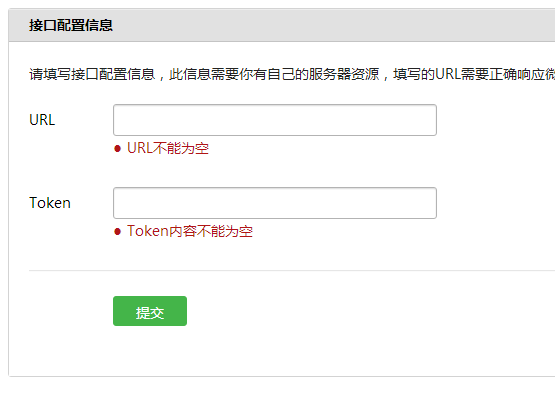
1.2 修改网页授权信息
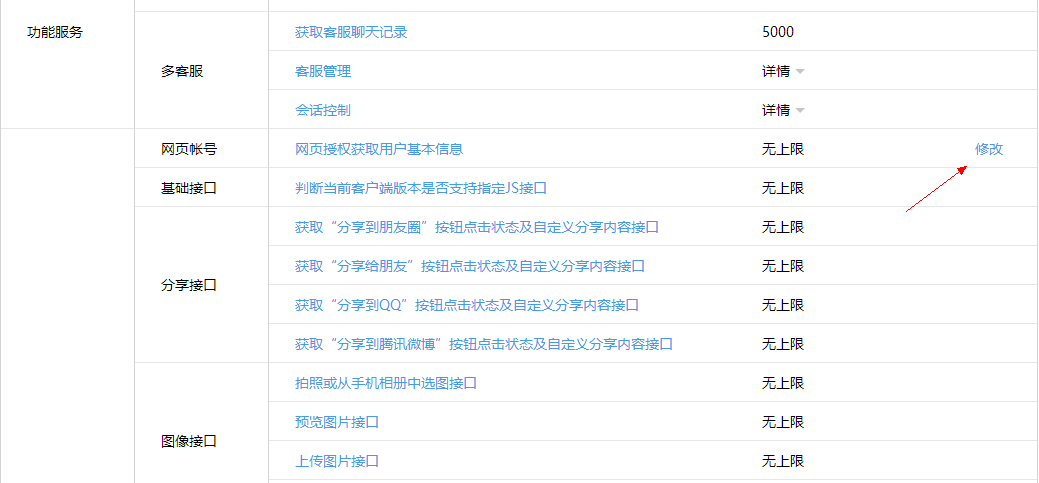
点击“修改”后在弹出页面填入你的网站域名:
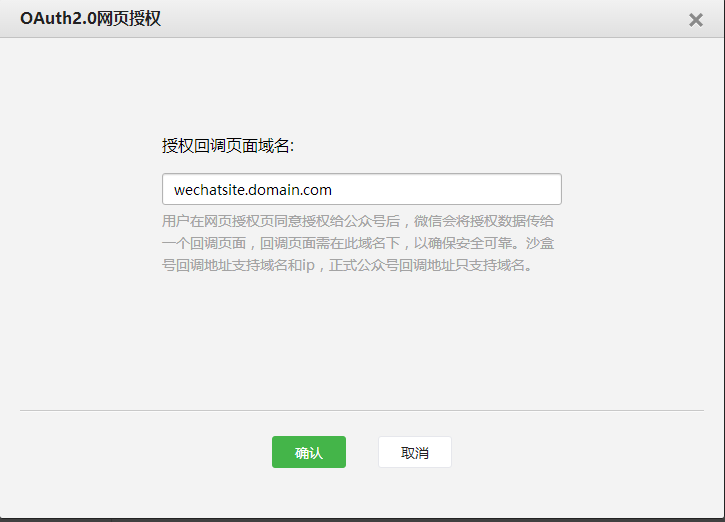
2 新建网站项目
2.1 选择ASP.NET Core Web Application 模板

2.2 选择Web 应用程序,并更改身份验证为个人用户账户
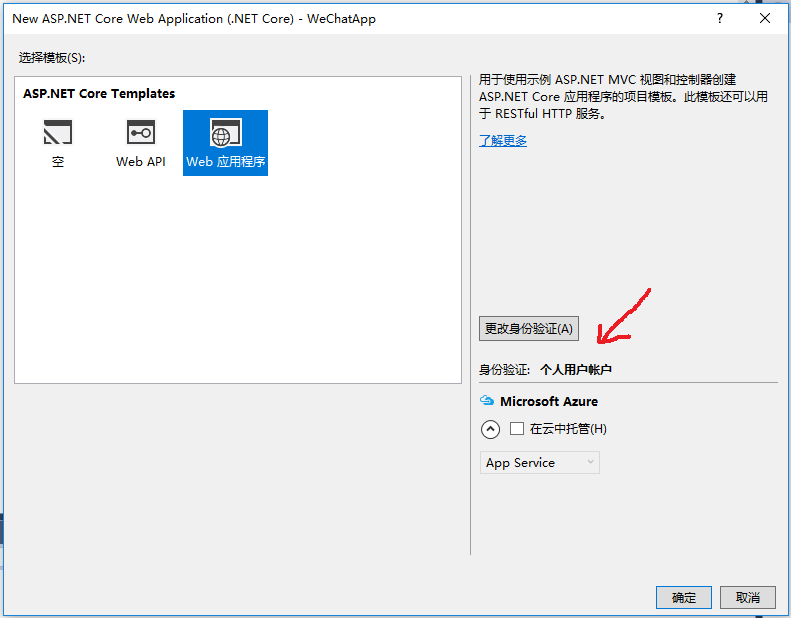
3 集成微信登录功能
3.1添加引用
打开project.json文件,添加引用Microsoft.AspNetCore.Authentication.OAuth
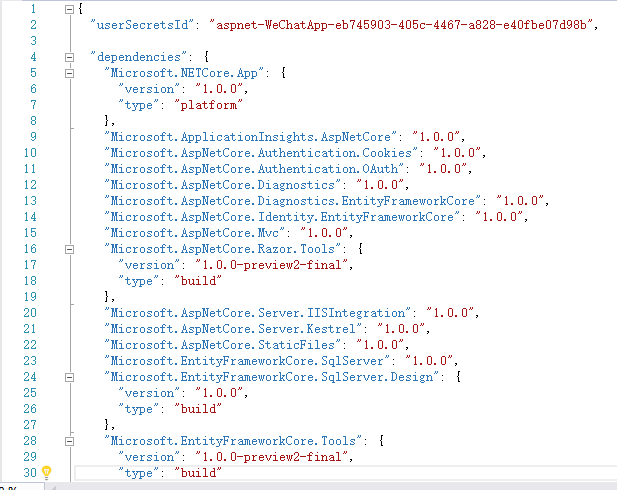
3.2 添加代码文件
在项目中新建文件夹,命名为WeChatOAuth,并添加代码文件(本文最后附全部代码)。
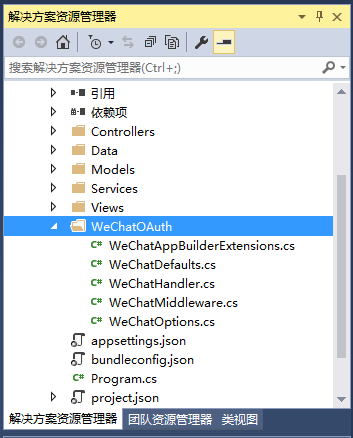
3.3 注册微信登录中间件
打开Startup.cs文件,在Configure中添加代码:
|
1
2
3
4
5
6
7
8
|
app.UseWeChatAuthentication(new WeChatOptions(){ AppId = "******", AppSecret = "******"}); |
注意该代码的插入位置必须在app.UseIdentity()下方。
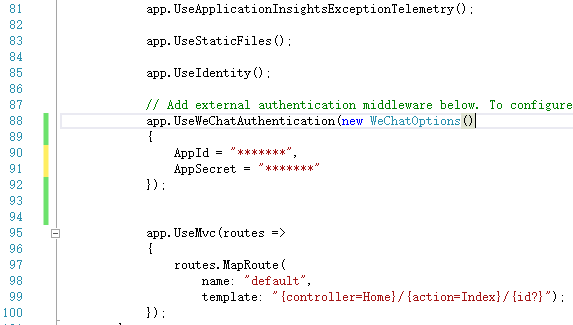
4 代码
:
|
1
2
3
4
5
6
7
8
9
10
11
12
13
14
15
16
17
18
19
20
21
22
23
24
25
26
27
28
29
30
31
32
33
34
35
36
37
38
39
40
41
42
43
44
45
46
47
48
49
50
|
// Copyright (c) .NET Foundation. All rights reserved.// Licensed under the Apache License, Version 2.0. See License.txt in the project root for license information.using System;using Microsoft.AspNetCore.Authentication.WeChat;using Microsoft.Extensions.Options;namespace Microsoft.AspNetCore.Builder{ /// <summary> /// Extension methods to add WeChat authentication capabilities to an HTTP application pipeline. /// </summary> public static class WeChatAppBuilderExtensions { /// <summary> /// Adds the <see cref="WeChatMiddleware"/> middleware to the specified <see cref="IApplicationBuilder"/>, which enables WeChat authentication capabilities. /// </summary> /// <param name="app">The <see cref="IApplicationBuilder"/> to add the middleware to.</param> /// <returns>A reference to this instance after the operation has completed.</returns> public static IApplicationBuilder UseWeChatAuthentication(this IApplicationBuilder app) { if (app == null) { throw new ArgumentNullException(nameof(app)); } return app.UseMiddleware<WeChatMiddleware>(); } /// <summary> /// Adds the <see cref="WeChatMiddleware"/> middleware to the specified <see cref="IApplicationBuilder"/>, which enables WeChat authentication capabilities. /// </summary> /// <param name="app">The <see cref="IApplicationBuilder"/> to add the middleware to.</param> /// <param name="options">A <see cref="WeChatOptions"/> that specifies options for the middleware.</param> /// <returns>A reference to this instance after the operation has completed.</returns> public static IApplicationBuilder UseWeChatAuthentication(this IApplicationBuilder app, WeChatOptions options) { if (app == null) { throw new ArgumentNullException(nameof(app)); } if (options == null) { throw new ArgumentNullException(nameof(options)); } return app.UseMiddleware<WeChatMiddleware>(Options.Create(options)); } }} |
WeChatDefaults.cs:
|
1
2
3
4
5
6
7
8
9
10
11
12
13
14
15
16
|
// Copyright (c) .NET Foundation. All rights reserved.// Licensed under the Apache License, Version 2.0. See License.txt in the project root for license information.namespace Microsoft.AspNetCore.Authentication.WeChat{ public static class WeChatDefaults { public const string AuthenticationScheme = "WeChat"; public static readonly string AuthorizationEndpoint = "https://open.weixin.qq.com/connect/oauth2/authorize"; public static readonly string TokenEndpoint = "https://api.weixin.qq.com/sns/oauth2/access_token"; public static readonly string UserInformationEndpoint = "https://api.weixin.qq.com/sns/userinfo"; }} |
WeChatHandler.cs
|
1
2
3
4
5
6
7
8
9
10
11
12
13
14
15
16
17
18
19
20
21
22
23
24
25
26
27
28
29
30
31
32
33
34
35
36
37
38
39
40
41
42
43
44
45
46
47
48
49
50
51
52
53
54
55
56
57
58
59
60
61
62
63
64
65
66
67
68
69
70
71
72
73
74
75
76
77
78
79
80
81
82
83
84
85
86
87
88
89
90
91
92
93
94
95
96
97
98
99
100
101
102
103
104
105
106
107
108
109
110
111
112
113
114
115
116
117
118
119
120
121
122
123
124
125
126
127
128
129
130
131
132
133
134
135
136
137
138
139
140
141
142
143
144
145
146
147
148
149
150
151
152
153
154
155
156
157
158
159
160
161
162
163
164
165
166
167
168
169
170
171
172
173
174
175
176
177
178
179
180
181
182
183
184
185
186
187
188
189
190
191
192
193
194
195
196
197
198
199
200
201
202
203
204
205
206
207
208
209
210
211
212
213
214
215
216
217
218
219
220
221
222
223
224
225
226
227
228
229
230
231
232
233
234
235
236
237
238
239
240
241
242
243
244
245
246
247
248
249
250
251
252
253
254
255
256
257
258
259
260
|
// Copyright (c) .NET Foundation. All rights reserved.// Licensed under the Apache License, Version 2.0. See License.txt in the project root for license information.using Microsoft.AspNetCore.Authentication.OAuth;using Microsoft.AspNetCore.Builder;using Microsoft.AspNetCore.Http.Authentication;using Microsoft.AspNetCore.Http.Extensions;using Microsoft.Extensions.Primitives;using Newtonsoft.Json.Linq;using System;using System.Collections.Generic;using System.Net.Http;using System.Net.Http.Headers;using System.Security.Claims;using System.Text;using Microsoft.AspNetCore.Mvc;using System.Threading.Tasks;namespace Microsoft.AspNetCore.Authentication.WeChat{ internal class WeChatHandler : OAuthHandler<WeChatOptions> { public WeChatHandler(HttpClient httpClient) : base(httpClient) { } protected override async Task<AuthenticateResult> HandleRemoteAuthenticateAsync() { AuthenticationProperties properties = null; var query = Request.Query; var error = query["error"]; if (!StringValues.IsNullOrEmpty(error)) { var failureMessage = new StringBuilder(); failureMessage.Append(error); var errorDescription = query["error_description"]; if (!StringValues.IsNullOrEmpty(errorDescription)) { failureMessage.Append(";Description=").Append(errorDescription); } var errorUri = query["error_uri"]; if (!StringValues.IsNullOrEmpty(errorUri)) { failureMessage.Append(";Uri=").Append(errorUri); } return AuthenticateResult.Fail(failureMessage.ToString()); } var code = query["code"]; var state = query["state"]; var oauthState = query["oauthstate"]; properties = Options.StateDataFormat.Unprotect(oauthState); if (state != Options.StateAddition || properties == null) { return AuthenticateResult.Fail("The oauth state was missing or invalid."); } // OAuth2 10.12 CSRF if (!ValidateCorrelationId(properties)) { return AuthenticateResult.Fail("Correlation failed."); } if (StringValues.IsNullOrEmpty(code)) { return AuthenticateResult.Fail("Code was not found."); } //获取tokens var tokens = await ExchangeCodeAsync(code, BuildRedirectUri(Options.CallbackPath)); var identity = new ClaimsIdentity(Options.ClaimsIssuer); AuthenticationTicket ticket = null; if (Options.WeChatScope == Options.InfoScope) { //获取用户信息 ticket = await CreateTicketAsync(identity, properties, tokens); } else { //不获取信息,只使用openid identity.AddClaim(new Claim(ClaimTypes.NameIdentifier, tokens.TokenType, ClaimValueTypes.String, Options.ClaimsIssuer)); ticket = new AuthenticationTicket(new ClaimsPrincipal(identity), properties, Options.AuthenticationScheme); } if (ticket != null) { return AuthenticateResult.Success(ticket); } else { return AuthenticateResult.Fail("Failed to retrieve user information from remote server."); } } /// <summary> /// OAuth第一步,获取code /// </summary> /// <param name="properties"></param> /// <param name="redirectUri"></param> /// <returns></returns> protected override string BuildChallengeUrl(AuthenticationProperties properties, string redirectUri) { //加密OAuth状态 var oauthstate = Options.StateDataFormat.Protect(properties); // redirectUri = $"{redirectUri}?{nameof(oauthstate)}={oauthstate}"; var queryBuilder = new QueryBuilder() { { "appid", Options.ClientId }, { "redirect_uri", redirectUri }, { "response_type", "code" }, { "scope", Options.WeChatScope }, { "state", Options.StateAddition }, }; return Options.AuthorizationEndpoint + queryBuilder.ToString(); } /// <summary> /// OAuth第二步,获取token /// </summary> /// <param name="code"></param> /// <param name="redirectUri"></param> /// <returns></returns> protected override async Task<OAuthTokenResponse> ExchangeCodeAsync(string code, string redirectUri) { var tokenRequestParameters = new Dictionary<string, string>() { { "appid", Options.ClientId }, { "secret", Options.ClientSecret }, { "code", code }, { "grant_type", "authorization_code" }, }; var requestContent = new FormUrlEncodedContent(tokenRequestParameters); var requestMessage = new HttpRequestMessage(HttpMethod.Post, Options.TokenEndpoint); requestMessage.Headers.Accept.Add(new MediaTypeWithQualityHeaderValue("application/json")); requestMessage.Content = requestContent; var response = await Backchannel.SendAsync(requestMessage, Context.RequestAborted); if (response.IsSuccessStatusCode) { var payload = JObject.Parse(await response.Content.ReadAsStringAsync()); string ErrCode = payload.Value<string>("errcode"); string ErrMsg = payload.Value<string>("errmsg"); if (!string.IsNullOrEmpty(ErrCode) | !string.IsNullOrEmpty(ErrMsg)) { return OAuthTokenResponse.Failed(new Exception($"ErrCode:{ErrCode},ErrMsg:{ErrMsg}")); } var tokens = OAuthTokenResponse.Success(payload); //借用TokenType属性保存openid tokens.TokenType = payload.Value<string>("openid"); return tokens; } else { var error = "OAuth token endpoint failure"; return OAuthTokenResponse.Failed(new Exception(error)); } } /// <summary> /// OAuth第四步,获取用户信息 /// </summary> /// <param name="identity"></param> /// <param name="properties"></param> /// <param name="tokens"></param> /// <returns></returns> protected override async Task<AuthenticationTicket> CreateTicketAsync(ClaimsIdentity identity, AuthenticationProperties properties, OAuthTokenResponse tokens) { var queryBuilder = new QueryBuilder() { { "access_token", tokens.AccessToken }, { "openid", tokens.TokenType },//在第二步中,openid被存入TokenType属性 { "lang", "zh_CN" } }; var infoRequest = Options.UserInformationEndpoint + queryBuilder.ToString(); var response = await Backchannel.GetAsync(infoRequest, Context.RequestAborted); if (!response.IsSuccessStatusCode) { throw new HttpRequestException($"Failed to retrieve WeChat user information ({response.StatusCode}) Please check if the authentication information is correct and the corresponding WeChat Graph API is enabled."); } var user = JObject.Parse(await response.Content.ReadAsStringAsync()); var ticket = new AuthenticationTicket(new ClaimsPrincipal(identity), properties, Options.AuthenticationScheme); var context = new OAuthCreatingTicketContext(ticket, Context, Options, Backchannel, tokens, user); var identifier = user.Value<string>("openid"); if (!string.IsNullOrEmpty(identifier)) { identity.AddClaim(new Claim(ClaimTypes.NameIdentifier, identifier, ClaimValueTypes.String, Options.ClaimsIssuer)); } var nickname = user.Value<string>("nickname"); if (!string.IsNullOrEmpty(nickname)) { identity.AddClaim(new Claim(ClaimTypes.Name, nickname, ClaimValueTypes.String, Options.ClaimsIssuer)); } var sex = user.Value<string>("sex"); if (!string.IsNullOrEmpty(sex)) { identity.AddClaim(new Claim("urn:WeChat:sex", sex, ClaimValueTypes.String, Options.ClaimsIssuer)); } var country = user.Value<string>("country"); if (!string.IsNullOrEmpty(country)) { identity.AddClaim(new Claim(ClaimTypes.Country, country, ClaimValueTypes.String, Options.ClaimsIssuer)); } var province = user.Value<string>("province"); if (!string.IsNullOrEmpty(province)) { identity.AddClaim(new Claim(ClaimTypes.StateOrProvince, province, ClaimValueTypes.String, Options.ClaimsIssuer)); } var city = user.Value<string>("city"); if (!string.IsNullOrEmpty(city)) { identity.AddClaim(new Claim("urn:WeChat:city", city, ClaimValueTypes.String, Options.ClaimsIssuer)); } var headimgurl = user.Value<string>("headimgurl"); if (!string.IsNullOrEmpty(headimgurl)) { identity.AddClaim(new Claim("urn:WeChat:headimgurl", headimgurl, ClaimValueTypes.String, Options.ClaimsIssuer)); } var unionid = user.Value<string>("unionid"); if (!string.IsNullOrEmpty(unionid)) { identity.AddClaim(new Claim("urn:WeChat:unionid", unionid, ClaimValueTypes.String, Options.ClaimsIssuer)); } await Options.Events.CreatingTicket(context); return context.Ticket; } }} |
WeChatMiddleware.cs
|
1
2
3
4
5
6
7
8
9
10
11
12
13
14
15
16
17
18
19
20
21
22
23
24
25
26
27
28
29
30
31
32
33
34
35
36
37
38
39
40
41
42
43
44
45
46
47
48
49
50
51
52
53
54
55
56
57
58
59
60
61
62
63
64
65
66
67
68
69
70
71
72
73
74
75
76
77
78
79
80
81
82
83
84
85
86
87
88
89
|
// Copyright (c) .NET Foundation. All rights reserved.// Licensed under the Apache License, Version 2.0. See License.txt in the project root for license information.using System;using System.Globalization;using System.Text.Encodings.Web;using Microsoft.AspNetCore.Authentication.OAuth;using Microsoft.AspNetCore.Builder;using Microsoft.AspNetCore.DataProtection;using Microsoft.AspNetCore.Http;using Microsoft.Extensions.Logging;using Microsoft.Extensions.Options;namespace Microsoft.AspNetCore.Authentication.WeChat{ /// <summary> /// An ASP.NET Core middleware for authenticating users using WeChat. /// </summary> public class WeChatMiddleware : OAuthMiddleware<WeChatOptions> { /// <summary> /// Initializes a new <see cref="WeChatMiddleware"/>. /// </summary> /// <param name="next">The next middleware in the HTTP pipeline to invoke.</param> /// <param name="dataProtectionProvider"></param> /// <param name="loggerFactory"></param> /// <param name="encoder"></param> /// <param name="sharedOptions"></param> /// <param name="options">Configuration options for the middleware.</param> public WeChatMiddleware( RequestDelegate next, IDataProtectionProvider dataProtectionProvider, ILoggerFactory loggerFactory, UrlEncoder encoder, IOptions<SharedAuthenticationOptions> sharedOptions, IOptions<WeChatOptions> options) : base(next, dataProtectionProvider, loggerFactory, encoder, sharedOptions, options) { if (next == null) { throw new ArgumentNullException(nameof(next)); } if (dataProtectionProvider == null) { throw new ArgumentNullException(nameof(dataProtectionProvider)); } if (loggerFactory == null) { throw new ArgumentNullException(nameof(loggerFactory)); } if (encoder == null) { throw new ArgumentNullException(nameof(encoder)); } if (sharedOptions == null) { throw new ArgumentNullException(nameof(sharedOptions)); } if (options == null) { throw new ArgumentNullException(nameof(options)); } if (string.IsNullOrEmpty(Options.AppId)) { throw new ArgumentException(string.Format(CultureInfo.CurrentCulture, nameof(Options.AppId))); } if (string.IsNullOrEmpty(Options.AppSecret)) { throw new ArgumentException(string.Format(CultureInfo.CurrentCulture, nameof(Options.AppSecret))); } } /// <summary> /// Provides the <see cref="AuthenticationHandler{T}"/> object for processing authentication-related requests. /// </summary> /// <returns>An <see cref="AuthenticationHandler{T}"/> configured with the <see cref="WeChatOptions"/> supplied to the constructor.</returns> protected override AuthenticationHandler<WeChatOptions> CreateHandler() { return new WeChatHandler(Backchannel); } }} |
WeChatOptions.cs
|
1
2
3
4
5
6
7
8
9
10
11
12
13
14
15
16
17
18
19
20
21
22
23
24
25
26
27
28
29
30
31
32
33
34
35
36
37
38
39
40
41
42
43
44
45
46
47
48
49
50
51
52
53
54
55
56
57
58
59
60
61
62
|
// Copyright (c) .NET Foundation. All rights reserved.// Licensed under the Apache License, Version 2.0. See License.txt in the project root for license information.using System.Collections.Generic;using Microsoft.AspNetCore.Authentication.WeChat;using Microsoft.AspNetCore.Http;using Microsoft.AspNetCore.Identity;namespace Microsoft.AspNetCore.Builder{ /// <summary> /// Configuration options for <see cref="WeChatMiddleware"/>. /// </summary> public class WeChatOptions : OAuthOptions { /// <summary> /// Initializes a new <see cref="WeChatOptions"/>. /// </summary> public WeChatOptions() { AuthenticationScheme = WeChatDefaults.AuthenticationScheme; DisplayName = AuthenticationScheme; CallbackPath = new PathString("/signin-wechat"); StateAddition = "#wechat_redirect"; AuthorizationEndpoint = WeChatDefaults.AuthorizationEndpoint; TokenEndpoint = WeChatDefaults.TokenEndpoint; UserInformationEndpoint = WeChatDefaults.UserInformationEndpoint; //SaveTokens = true; //BaseScope (不弹出授权页面,直接跳转,只能获取用户openid), //InfoScope (弹出授权页面,可通过openid拿到昵称、性别、所在地。并且,即使在未关注的情况下,只要用户授权,也能获取其信息) WeChatScope = InfoScope; } // WeChat uses a non-standard term for this field. /// <summary> /// Gets or sets the WeChat-assigned appId. /// </summary> public string AppId { get { return ClientId; } set { ClientId = value; } } // WeChat uses a non-standard term for this field. /// <summary> /// Gets or sets the WeChat-assigned app secret. /// </summary> public string AppSecret { get { return ClientSecret; } set { ClientSecret = value; } } public string StateAddition { get; set; } public string WeChatScope { get; set; } public string BaseScope = "snsapi_base"; public string InfoScope = "snsapi_userinfo"; }} |
以上就是本文的全部内容,希望对大家的学习有所帮助,也希望大家多多支持服务器之家。














